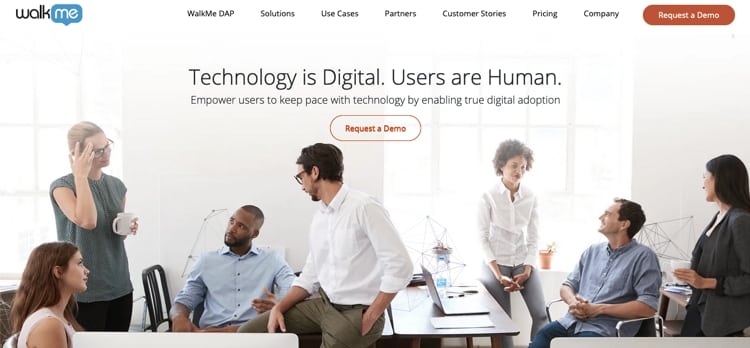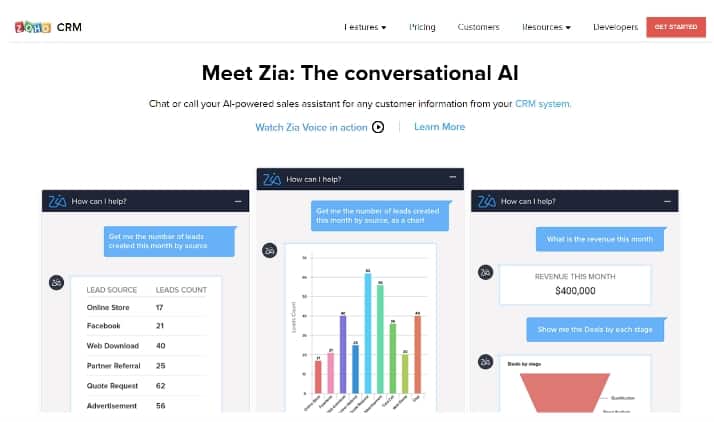A Big Business Guide to Digital Adoption in 2019

It goes without saying that modern technology has grown to become an integral part of our everyday lives, both personally and professionally. It’s something that so many of us take for granted, just like having a microwave and a refrigerator in the kitchen. You just know it’s there and you don’t even think about it.
At the same time, many corporations are not fully taking advantage of digital adoption to the level that they could be, and as a result, they are leaving boundless opportunities on the table. As we move ahead through 2019 and beyond, it is of paramount importance that you business include digital adoption among its list of primary objectives. But first, you must understand what that even means.
What Is Digital Adoption?
Before you can tackle the challenge of digital adoption both within and beyond your organization (more on that in a moment), we must first define the term.
According to Forbes: “Digital adoption, quite simply, refers to achieving a state within your company where all of your digital tools and assets are leveraged to the fullest extent.”
And this is where so many coordinators, managers, executives and entire companies misinterpret the term altogether. They come to believe that “digital adoption” refers only to the adoption of said tools and assets. “Oh, we already keep our most important files on the company intranet,” they might say. “Every employee is on Slack already,” they might add. From Trello to Gtmhub to any number of other tools, companies have a lot of options today.
However, it is critically important to key into the last part of that definition. Simple adoption of the digital tools and technology is insufficient. These tools must be “leveraged to the fullest extent” in such a way as to maximize the positive impact they can have on your organization.
Why Is It Important?
It’s obvious enough that a variety of industries comprise the global economy. There are companies that work in real estate development, others that manufacture cookware, some that work in publishing and broadcasting, and others still are focused on investments and wealth management. And as varied and as distinct as these various industries and verticals may be, they have one crucial characteristic in common: technology.
While it may have once been the case that “tech companies” made up a distinct category of their own — and there are certainly companies like Intel or Google or Apple that work almost exclusively in this space — the truth of the matter is that every company today needs to be fully invested in its technology if it hopes to succeed in the short term and in the long term.
Whether you operate primarily as a B2C, a B2B, or any number of other B2 possibilities, technology plays a mission critical role. Every company needs a website. Every company needs a technological infrastructure in place where employees can communicate with one another effectively. Perhaps you have a mobile app, an e-commerce store, servers filled with sensitive customer data, complex data analysis algorithms… the list goes on and on. And these need to be leveraged to their fullest extent.
Imagine this. You have 20,000-square-foot storefront and it has been optimally designed with suitable shelf space. There are dozens of sales personnel on your payroll, and you’ve stocked up on inventory for an anticipated sales rush. You have the assets you need. However, for some inexplicable reason, you only put out a handful of products, and only one salesperson is on the floor. What sort of results can you expect at the end of your “big sale” day? Now imagine if you stocked those shelves with your ample inventory and you had far more salespeople out to assist customers. What sort of results would you expect then?
Digital adoption works in much the same way. It’s not enough to simply have the tools and digital assets in place. You need to utilize them to the fullest.
How Can Enterprise Leverage Digital Adoption?
So, now that you know what digital adoption is and why it’s important, the next question is to determine how to drive digital adoption, moving toward using these digital tools to their utmost potential. Just as there are tools for every other aspect of your business, there are tools and resources that can streamline this process.
An exceptional example of this is WalkMe. Billing itself as a “digital adoption platform,” Walkme allows you to “empower users to keep pace with technology by enabling true adoption.” With the platform, users can have a much easier time using any software, website, or app you may have. The solution will intelligently analyze these assets and automate processes, effectively enabling users to complete tasks more quickly and more easily.
Consider this from a customer perspective. They arrive on your website, but it has not been mobile optimized, and thus it renders poorly on their smartphone. Maybe the product catalog hasn’t been organized or laid out in an intuitive fashion to maximize sales. Perhaps the shopping cart or checkout process isn’t ideal either. With a platform with WalkMe, you can identify these potential pain points before they even happen, paving the way for an ideal customer journey.
A satisfied customer is one that will buy from you again and again. A dissatisfied customer may not even buy from you in the first place (and thus may not be a customer at all).
Beyond the User Experience
When thinking about digital adoption, it’s easy to think about it from the customer or user’s perspective. What can you do with your website to maximize sales? What can you do with your online service to maximize user engagement and interaction? What can you do with your mobile app to encourage more downloads or more in-app purchases. These are all fair considerations when you consider how to improve digital adoption among your user base.
But perhaps an even more profound consideration is digital adoption among your employees. Again, technology has gotten to the point where many of us take it for granted. Even beyond the basics, like email and web browsers, modern companies run a huge variety of software solutions, both local and in the cloud as a SaaS, and it is paramount that employees know how to maximize what these assets and tools can do.
These include such categories as human capital management, resource planning, inventory and logistics management (supply chain), and internal tools for networking, collaboration and communication. Especially when introducing new software into the workflow, and particularly when the software is going to be used across the whole company and not just in one department, it can be a challenge to staff up to speed on what the tool can do and how they should use it.
Consider the hugely competitive customer relationship management (CRM) category. Zoho CRM is among one of the best, earning a Editor’s Choice Award from PCMag, but none of that will mean much if team members don’t know how to use it effectively. Maybe they don’t know about Zia, Zoho CRM’s conversational sales assistant powered by artificial intelligence. Perhaps they don’t know how to integrate it effectively into other services they’re already using, like Salesforce and Quickbooks.
It would be impossible for any one manager or executive to have an intimate understanding of every piece of software, every business tool, every digital assets out there. And this is why utilizing digital adoption platforms like WalkMe are so important, as they can reveal areas that may otherwise go unnoticed or underutilized. Complex business activities can be automated and simplified. Employee productivity is boosted, as they can focus on what they do best, rather than spending their whole day troubleshooting through complicated programs.
Challenges and Opportunities
Of course, as with all aspects of running a successful business, digital adoption is not without its potential challenges and areas of possible resistance. However, it is completely possible to transform these challenges into powerful opportunities for growth.
- Competition: From a user-facing perspective, any digital tool is going to be faced with competition. By placing a focus on digital adoption, you can work to ensure users can getting the most out of what you have to offer, and that the experience is a positive one.
- Training and Onboarding: Whenever you introduce new software into the workflow, or you hire new team members, you will need to go through the suitable steps of training them for how to use this tool or resource. This can be a great learning opportunity, as new hires may have insights and experiences that veteran staff may have overlooked.
- Support: Digital tools and assets are not static. They change and evolve over time, and this is why ongoing support is so important. This allows for growth as a company too, because you can leverage these updates to your advantage.
- Lack of Integration: While it is true that a wealth of digital tools are available, it’s not enough to throw them all into a toolbox and hope for the best. They need to be suitably integrated with and “talking to” one another. WalkMe can help with automating these sorts of processes, so employees aren’t stuck with redundant workflows.
- Resistance to Change: Users and team members alike may be resistant to change, because they have achieved a certain comfort level with the status quo. The crucial thing to learn from digital adoption, in this context, is to demonstrate the incredible benefits that the new tools and resources can provide and how they will ultimately make their lives better.
It’s Already the New Normal
The smartphone in your pocket (or possibly in your hand right now as you read these words) has completely and irreversibly revolutionized the modern human experience. It wasn’t that long ago that such a powerful computer in such a compact and truly mobile package would have been the stuff of science fiction. These days, the “phone” part of the smartphone is far less important than the screen, the camera, the web browser, and the multitude of apps. It can do almost anything a “real” computer can do, and then some.
Digital adoption can and does happen quickly. And when it is leveraged in a purpose-driven way, it can truly improve the lives of your users and team members alike. You don’t want your company to be left behind as your competitors continue to move forward into the future. After all, you don’t want to be the one with a flip phone in a room full of iPhones, do you?
Have you read?
# World’s Best Countries To Invest In Or Do Business.
# Countries With The Best Quality of Life, 2019.
# Most Startup Friendly Countries In The World.
# The World’s Safest Cities Ranking.
# Global Passport Ranking, 2019.
Bring the best of the CEOWORLD magazine's global journalism to audiences in the United States and around the world. - Add CEOWORLD magazine to your Google News feed.
Follow CEOWORLD magazine headlines on: Google News, LinkedIn, Twitter, and Facebook.
Copyright 2025 The CEOWORLD magazine. All rights reserved. This material (and any extract from it) must not be copied, redistributed or placed on any website, without CEOWORLD magazine' prior written consent. For media queries, please contact: info@ceoworld.biz











